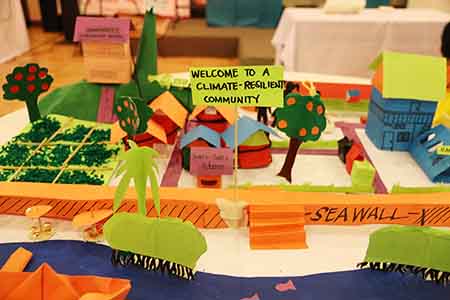Description
The Apocalypse Project is an interdisciplinary art platform that promotes climate change awareness and adaptation through participatory public art. I conduct art workshops and speak to local communities to collaborate with me on art pieces and present them in exhibitions. The next community I’m targeting is the Batak tribe in the rainforest of Palawan in the Philippines.
Projects include sculptures, perfumes, and illustrations that illustrate climate change risk, as well as forums that allow people to share sustainable solutions. By allowing people impacted by climate change — which is to say, everyone — to contribute with their ideas and distilling these into art pieces that can be shown in an exhibition, whether physically or digitally, this project allows to communicate the universality and humanity of climate change impacts and allows people to share ideas that will benefit their communities. A secondary outcome would be a proposed open source art curriculum designed to address climate change adaptation and mitigation targeted towards children and youth, and to be distributed to the community and schools that may be interested.
Objectives and beneficiaries
There are three key objectives of this project: 1) to utilize art as a tool for bringing out ideas and experiences that do not normally come out in policy making and typical educational and media tools, 2) to allow for a conversation between communities as different as the Global North and South in terms of climate change experiences and to document these, and 3) to create an art curriculum that will let communities do this for themselves.
Beneficiaries include the community I will do a project with, e.g. the Batak tribe in Palawan in the Philippines, as well as schools that may wish to include art in their climate change curriculum.
Strong points of the solution
As an artist who has done this for five years, communicating climate change has developed to include additional layers of complexity. Whereas before, “climate change” was a new term that needed a lot of explanation, now the main challenge is to communicate the systemic issues that caused climate change to begin with. One problem that has always presented itself to me is wealth inequality, and by extension, a lack of communication with respect to climate change experiences by, e.g. a person whose house was destroyed by a hurricane vs someone who can afford to change zip codes.
Climate change is a dry and inaccessible issue, and art can get people more engaged. Art allows the quietest participants - or those who have been most traumatized - to be able to voice their opinions, albeit not in a typical sense. The power of art, by virtue of its aesthetic and universal appeal, allows for the amplification of these voices through a variety of media, such as in physical exhibitions, digital media, and press.
Expected results and benefits for climate change adaptation and mitigation
I intend to work with the Batak community for two months and expect to conduct several art workshops that ask questions about their experiences with climate change and how they want to transform their community to be more resilient to its effects. The result will be sculptures, installations, and visual media — usually at least five artworks — that illustrate the challenges and goals that the community has with respect to climate change adaptation and mitigation.
I also intend to design an arts curriculum that the community can use and distribute this to interested communities, schools, and institutions. I intend for this to allow the community to engage in climate change issues despite fear and uncertainty, and to allow for new ideas to be raised and discussed.
Scalability potential of the solution
As an artist who has done climate change art and art education in eight countries, I believe that there is a universality to what I have discovered in communities as far from each other as Thailand and the Amazon. What I intend to do is to keep this conversation going through the implementation of another collaboration with another new community, but at the same time allow for the replication of this model through the creation of an arts curriculum that people can use without me.
An art exhibition will showcase results, while the arts curriculum will illustrate the theoretical framework through which these pieces were created and empower users to do similar projects within their communities.
[Editor's Note: All information published as submitted by the author(s). Minor edits may have been made for length and clarity.]






